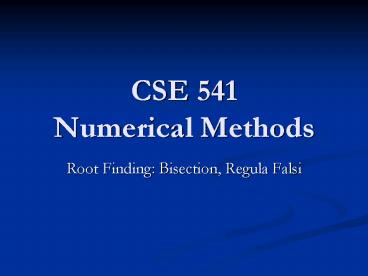CSE 541 Numerical Methods - PowerPoint PPT Presentation
1 / 24
Title:
CSE 541 Numerical Methods
Description:
... 541. Numerical Methods. Root Finding: Bisection, Regula Falsi. 9/24/09. 2. OSU ... Regula Falsi. Benefits: If the function is close to linear in the interval ... – PowerPoint PPT presentation
Number of Views:171
Avg rating:3.0/5.0
Title: CSE 541 Numerical Methods
1
CSE 541Numerical Methods
- Root Finding Bisection, Regula Falsi
2
Root Finding
- Where does the function cross the x-axis?
- Set f(x) 0, solve for x
- More than once maybe???
- More generally, set f(x, y, z, ) 0
- Phrase it differently f(x,y,z,) g(x,y,z,)
roots
3
Motivation
- Take well known functions such as polynomials
- For example
- f(x) x2 2x 3
- Two roots at r -1 and r 3
- f(-1) 1 2 3 0
- f(3) 9 6 3 0
- We can also look at f in its factored form
- f(x) x2 2x 3 (x 1)(x 3)
4
Factored Form of Functions
- The factored form is not limited to polynomials
- Consider
- f(x) x sin x sin x
- A root exists at x 1
- f(x) (x 1) sin x
- And
- sin x sin kp 0 Þ (x p) x (x p) (x 2p)
(x 3p)
5
Examples
- Compute Ö2?
- x Ö2
- x2 2
- In general,
- xp c ? xp c 0
6
Root Finding Algorithm
- Limited information about the function
- Assume we are allowed to evaluate the function
anywhere and as many times as we want - How do we find roots?
7
Domain Interval
- Interval Two locations on the domain, a and b,
- where x Îa, b, where a lt b
- Lets define a couple of intervals
- How do we know if there is a root in the interval?
?
?
8
Observation
- Evaluate the function at endpoints a and b
- f (a) gt 0 and f (b) gt 0
a
b
9
Observation
- Evaluate the function at endpoints a and b
- f (a) gt 0 and f (b) lt 0
a
b
10
Bracketing Techniques
- Surround the root (solution)
- Find an interval a, b that contains the root
- So f (a) f (b) lt 0
- What is a good approximation to our solution?
- Can we improve our approximation?
11
Bisection Method
- c(ab)/2
f(a)gt0
f(c)gt0
a
b
c
f(b)lt0
12
Bisection Method
a c f(a)gt0
b
c
a
f(c)lt0
f(b)lt0
13
Bisection Method
b c f(b)lt0
b
a
c
14
Convergence Error
- Will this always converge?
- Intermediate Value Theorem
- (Continuous functions)
- At any step in the algorithm, what is the error
of our approximation? - I.e., root c
15
Error Estimation
- Use error bound and relative error
c
x
16
Error Estimate
- What does this mean in binary mode?
- err0 ? b-a
- err1 ? b-a/2
- erri1 ? erri/2 b-a/2i1
- We gain an extra bit each iteration!!!
17
Convergence
- The bisection method converges linearly
- r ci1 lt ½ r ci C r ci
- Linear Convergence Theorem
- Not bad, why do I need anything else?
- Can we do better?
18
A Note on Functions
- Functions can be simple, but I may need to
evaluate it many many times. - Or, a function can be extremely complicated.
Consider - Interested in the configuration of air vents
(position, orientation, direction of flow) that
makes the temperature in the room at a particular
position (teachers desk) equal to 72. - Is this a function?
19
A Note on Functions
- This function may require a complex
three-dimensional heat-transfer coupled with a
fluid-flow simulation to evaluate the function - ? hours of computational time on a
supercomputer!!! - May not necessarily even be computational
20
Bisection Method
- Given a and b, such that f(a)f(b)lt0
- c (a b)/2.0 // Find the midpoint
- while( ????? )
- if( f(a)f(c) lt 0 ) // root in the left half
- b c
- else // root in the right half
- a c
- c (a b)/2.0 // Find the new midpoint
- return c
- Stopping criteria?
21
Regula Falsi
- New Idea
- Assume the function is linear within the bracket
- Construct a line and use it to find the
intersection with the x-axis
22
Regula Falsi
f(c)lt0
c
a
b
23
Regula Falsi
- Benefits
- If the function is close to linear in the
interval - If the root is much closer to one side
b
a
c
24
Bracketing Methods
- Guaranteed convergence
- Convergence typically slower than open methods
- Relies on identifying two points a and b
initially such that - f(a) f(b) lt 0
- Use to find approximate location of roots
- Polish with open methods

